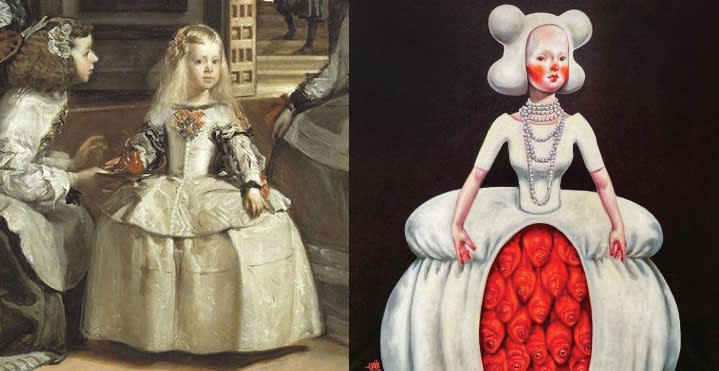
Through a complex compositional process Humanity writes its modern artistic symphony, operating with an unintentional and continuous deconstruction and restoration of the subconscious. Stirring the symbology of human history, retracting the rooms of memory and opening new doors on contemporary feeling, we are inviting you to join us on a fascinating and intriguing journey through time, to explore our selection of contemporary artworks in relationship with former masterpieces belonging to classical and modern art. Check out how themes and motifs are reinterpreted by our artist Afarin Sajedi, assuming new and refreshing expression.

Afarin Sajedi's colour palette aims to vivify the profound inner feelings of the woman depicted, who decides to trust herself in any role and situation. Sajedi's intense and ironic paintings and characthers evoke the elaborated nuances of Shakespeare's and Lars Von Trier's dramas, as much as Cervantes and Calvino's surreal adventures.

For this particular painting Sajedi took inspiration from an artwork that has been dear to her for many years: “Las Meninas” by Diego Velázquez.
“I have always admired the works of Diego Velázquez, as well as many other great artists. I've especially enjoyed the magnificent portraits that Velázquez has painted, particularly the dazzling eyes and youth portrayal. However Las Meninas by Diego Velázquez has always been a particular artwork that I have considered dear for me throughout the years. Particularly the princess in the centre painted with soft golden hair and pink cheeks inspires my artwork called Princesse” Afarin Sajedi stated.

Diego Rodriguez de Silva y Velázquez was born in 1599 in Seville, Spain. He had a gift for painting from an early age and became an apprentice for Juan de Herrera. Velázquez artworks have always displayed a mastery of light and shadow, specifically for detailed surfaces and texture, similar to other Baroque masters, like his italian precursor Caravaggio.

In the center of Las Meninas stands the princess, Doña Margarita Maria of Austria, one of the artist's favourite subjects (he would paint her portrait several times). In the painting, she wears a lush cream-coloured gown with a delicate skirt and sleeves. The princess is rather angelic, reflecting the stream of natural light that filters into the pictures. To the left and right are the Meninas, also known as the ladies-in-waiting, who would accompany and attend to the young princess in her daily routine.
Similarly in the artwork by Afarin Sajedi the subject is portrayed with a delicate dress, giving evidence of being influenced by 1600' s clothing like in Las Meninas. In Sajedi's work, the Princesse's expressive gaze, the parted lips and blushing cheeks reveals a strong inner conflict between fear and hope. Whilst they seem to be submerged into a deep sea of quietness and comfortable silence, deep emotions shine through her misty eyes and the tired face that the artist depicts in a cathartic stand.


